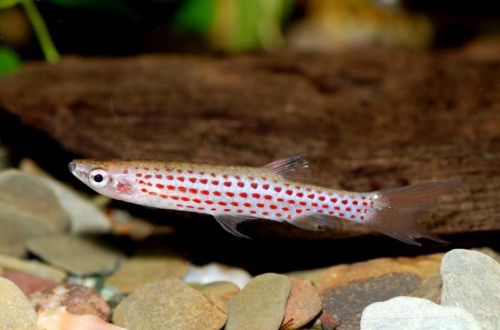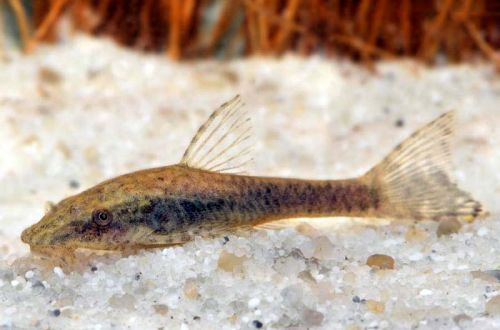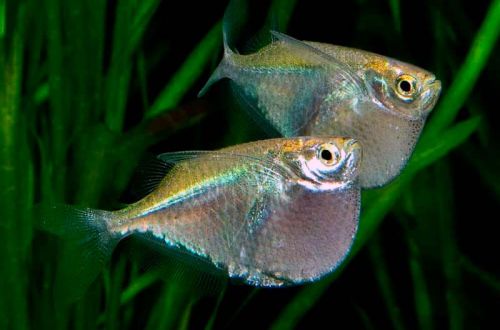
Spotted Copeina
Spotted Copeina or Kopella Meinke, scientific name Copella meinkeni, belongs to the Lebiasinidae family. Until 2006, it was considered a variety of Kopein Natterer. Now it is an independent species, although a number of sources still use the erroneous name. Bright beautiful fish, relatively easy to keep and compatible with most other species.

Contents
Habitat
Comes from South America. The natural habitat covers vast areas of the central part of the Amazon basin. The fish avoids the main river channels and inhabits small streams and rivers. During the annual rainy season, it swims to flooded areas of the rainforest. A typical biotope is a reservoir with a stagnant reservoir or a weak current, containing a large amount of plant organic matter, due to the decomposition of which the water acquires a brown tint.
Brief information:
- The volume of the aquarium – from 50 liters.
- Temperature – 20-28°C
- Value pH — 4.0–7.0
- Water hardness – soft (1-10 dGH)
- Substrate type – sandy
- Lighting – subdued
- Brackish water – no
- Water movement is weak
- The size of the fish is about 4 cm.
- Nutrition – any with a combination of live food with herbal supplements
- Temperament – conditionally peaceful, during the spawning period, males may show some hostility
Description
Adult individuals reach a length of about 4 cm. The color is silver or pinkish with rows of red dots. Males are noticeably larger and brighter than females, which is especially evident during the mating season.
Food
An omnivorous species, will accept most popular protein-rich foods (flakes, pellets, etc.). brine shrimp, daphnia, small bloodworms, Drosophila flies, live or frozen, will be a great addition.
Maintenance and care, arrangement of the aquarium
The optimal size of an aquarium for a flock of 8-10 fish starts from 50-60 liters or a paludarium with a similar volume of water. Due to the nature of reproduction (more on this below), the water level should not reach the edge of the tank by 5-10 cm or more, and it is also recommended to use vegetation hanging over the surface when decorating.
Spotted Kopeina prefers subdued lighting and will look more harmonious in an environment reminiscent of the natural environment, floating among thickets of plants and snags.
A useful design element will be the leaves of some trees, placed on top of the ground. During decomposition, processes similar to those that occur in the habitats of this species of fish will begin to occur – the water will turn brown due to the gradual saturation with tannins. The latter, in turn, have a positive effect on the chemical composition of water, in particular by lowering pH and dGH.
Successful long-term maintenance depends on many factors, the most important of which are water parameters. It is necessary to maintain the temperature regime and hydrochemical parameters in the acceptable range of values, to prevent the concentration of products of the nitrogen cycle (ammonia, nitrites, nitrates) from exceeding and pollution of the aquarium. Stable water conditions are ensured through regular maintenance procedures (water changes, waste disposal, etc.) and the installation of the necessary equipment.
Behavior and Compatibility
A peaceful, mobile fish, it gets along well with other non-aggressive species of a comparable size. It is desirable to maintain the size of the group at least 8–10 individuals in a mixed composition. Males will compete with each other for the attention of females by showing off their best colors. This “competition” occurs without any skirmishes, although during the mating season, males can be quite zealous in guarding their territories.
Breeding / breeding
In a mature aquarium, in the presence of sexually mature fish, fry will appear without any intervention from the aquarist (meaning the creation of certain conditions), however, their survival rate will be quite low. If breeding is planned, then it will be necessary to prepare in advance a separate tank with water conditions identical to the main aquarium, where fry are subsequently placed.
The process of reproduction in Kopein is very unusual. With the onset of the spawning season, the male occupies the territory around the proposed spawning ground and begins active courtship of the females. When a temporary pair is formed, the fish stick to spawning. Swimming to the surface and clinging to each other, they synchronously jump out of the water towards a low-hanging leaf or simply onto glass and stick to it for a few moments. During this time, they manage to attach a few eggs. After a series of jumps, the clutch grows to a dozen eggs. At the end of spawning, the female swims away. The male all the time until the fry appear takes care of the masonry, splashing water on it to protect it from drying out.
The incubation period lasts 36-72 hours. Emerging fry should be carefully moved to a separate tank to avoid predation by adult fish.
It is worth noting that if it is impossible to create a masonry above the water, the fish can lay eggs among the thickets of plants at the bottom. In this case, the male also stays close to the clutch to protect it.
Fish diseases
The main cause of fish health problems are unsuitable conditions of detention, causing a weakening of the immune system and thereby increasing susceptibility to diseases. Read more about symptoms and treatments in the Aquarium Fish Diseases section.





